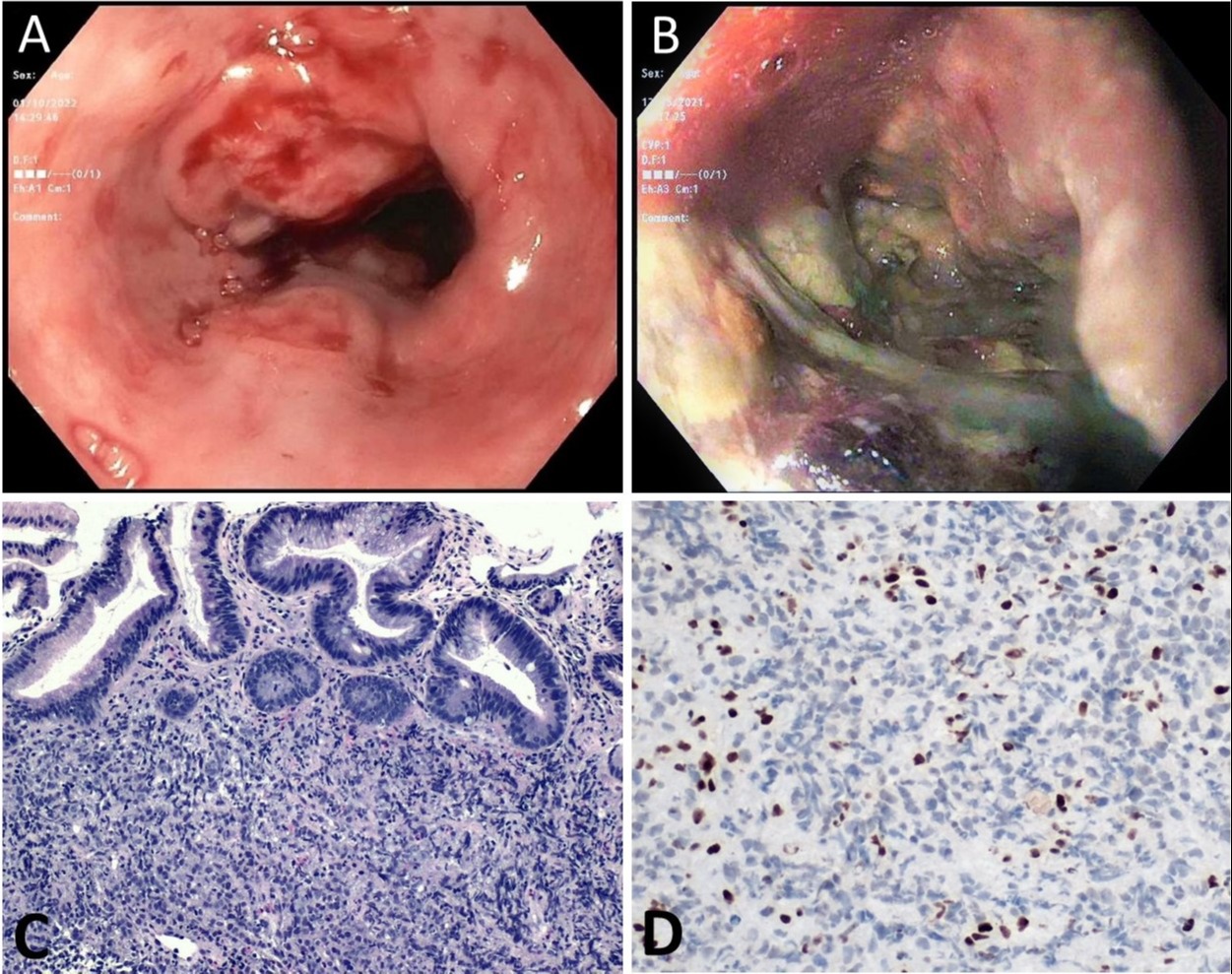Back


Poster Session B - Monday Morning
Category: Esophagus
B0232 - Case Series of SMARCA4-Deficient Undifferentiated Esophageal Carcinoma
Monday, October 24, 2022
10:00 AM – 12:00 PM ET
Location: Crown Ballroom

Has Audio

Omar T. Ahmed, MBBCh
UConn Health
Farmington, CT
Presenting Author(s)
Omar T. Ahmed, MBBCh, Ga Hie Nam, MD, Yuan Shui, MD, Jaimy Villavicencio Kim, MD, Haleh Vaziri, MD
UConn Health, Farmington, CT
Introduction: Undifferentiated esophageal carcinomas (UEC) are rare with aggressive behavior and dismal prognosis. An extremely rare subset is the SMARCA4-deficient UEC which has only been reported in 14 cases to-date. We present 2 patients with SMARCA4-deficient UEC.
Case Description/Methods: Case 1: A 39 y/o man presented with fever, nausea, abdominal pain, and weight loss. No significant social history. His grandfather had esophageal cancer in his 60s. Exam was significant for RUQ tenderness and hepatomegaly. Labs were unremarkable. Abdominal CT showed distal esophageal mass with hepatic metastasis. EGD revealed large, ulcerating distal esophageal mass (Fig. 1A). He passed away 1.5 months after initial presentation.
Case 2: A 64 y/o man with history of hiatal hernia and reflux disease, presented with persistent heartburn. He had history of smoking and alcohol abuse. Labs were unremarkable. Abdominal CT showed distal esophageal mass with hepatic metastases. EGD revealed necrotic, distal esophageal ulcer (Fig. 1B). He passed away 3 months after initial presentation.
Pathology Findings: The esophageal tumor biopsy in both cases showed undifferentiated tumor cells in solid sheets (Fig. 1C) and adjacent mucosa consistent with Barrett’s esophagus (BE). SMARCA4 was lost within the tumor cells (Fig. 1D).
Discussion: The SMARCA4 gene encodes the BRG1 protein which has a tumor suppressor role. Loss of SMARCA4 gene has been associated with undifferentiated highly aggressive tumors.
SMARCA4-deficient UEC is extremely rare and has been predominantly reported in elderly men. While our 64 y/o male patient fits the commonly reported demographics with risk factors for esophageal carcinoma, our 39 y/o patient did not have any potential risk factors and is the youngest reported patient. Additionally, the positive family history in the younger patient highlights the possibility of a germline mutation, which has been previously described in literature.
Histologically, the observed BE in the background of tumor cells in our cases, was also observed in most reported cases. The presence of BE and the distal esophageal location in these tumors suggest the possibility of this tumor arising from progressive de-differentiation of BE.
Our patients had evidence of metastatic disease on presentation, rapidly progressed and passed away within 1.5-3 months. The rapid mortality rate and the limited utility of SMARCA4 immunostaining could explain the underreporting of this disease.

Disclosures:
Omar T. Ahmed, MBBCh, Ga Hie Nam, MD, Yuan Shui, MD, Jaimy Villavicencio Kim, MD, Haleh Vaziri, MD. B0232 - Case Series of SMARCA4-Deficient Undifferentiated Esophageal Carcinoma, ACG 2022 Annual Scientific Meeting Abstracts. Charlotte, NC: American College of Gastroenterology.
UConn Health, Farmington, CT
Introduction: Undifferentiated esophageal carcinomas (UEC) are rare with aggressive behavior and dismal prognosis. An extremely rare subset is the SMARCA4-deficient UEC which has only been reported in 14 cases to-date. We present 2 patients with SMARCA4-deficient UEC.
Case Description/Methods: Case 1: A 39 y/o man presented with fever, nausea, abdominal pain, and weight loss. No significant social history. His grandfather had esophageal cancer in his 60s. Exam was significant for RUQ tenderness and hepatomegaly. Labs were unremarkable. Abdominal CT showed distal esophageal mass with hepatic metastasis. EGD revealed large, ulcerating distal esophageal mass (Fig. 1A). He passed away 1.5 months after initial presentation.
Case 2: A 64 y/o man with history of hiatal hernia and reflux disease, presented with persistent heartburn. He had history of smoking and alcohol abuse. Labs were unremarkable. Abdominal CT showed distal esophageal mass with hepatic metastases. EGD revealed necrotic, distal esophageal ulcer (Fig. 1B). He passed away 3 months after initial presentation.
Pathology Findings: The esophageal tumor biopsy in both cases showed undifferentiated tumor cells in solid sheets (Fig. 1C) and adjacent mucosa consistent with Barrett’s esophagus (BE). SMARCA4 was lost within the tumor cells (Fig. 1D).
Discussion: The SMARCA4 gene encodes the BRG1 protein which has a tumor suppressor role. Loss of SMARCA4 gene has been associated with undifferentiated highly aggressive tumors.
SMARCA4-deficient UEC is extremely rare and has been predominantly reported in elderly men. While our 64 y/o male patient fits the commonly reported demographics with risk factors for esophageal carcinoma, our 39 y/o patient did not have any potential risk factors and is the youngest reported patient. Additionally, the positive family history in the younger patient highlights the possibility of a germline mutation, which has been previously described in literature.
Histologically, the observed BE in the background of tumor cells in our cases, was also observed in most reported cases. The presence of BE and the distal esophageal location in these tumors suggest the possibility of this tumor arising from progressive de-differentiation of BE.
Our patients had evidence of metastatic disease on presentation, rapidly progressed and passed away within 1.5-3 months. The rapid mortality rate and the limited utility of SMARCA4 immunostaining could explain the underreporting of this disease.

Figure: Fig. 1A: EGD in case 1, showing a large, non-obstructing, circumferential, ulcerating mass in the lower third of the esophagus. Fig. 1B: EGD in case 2, showing a fungating, circumferential, necrotic, distal esophageal ulcer with stigmata of recent bleeding. Fig. 1C: Both tumor biopsies showed undifferentiated tumor cells consisting of epithelioid cells arranged in solid sheets with adjacent intestinal metaplasia (low magnification, H&E). Fig. 1D: Loss of SMARCA4/BRG1 within the tumor cells, while retained within inflammatory cells (internal control).
Disclosures:
Omar Ahmed indicated no relevant financial relationships.
Ga Hie Nam indicated no relevant financial relationships.
Yuan Shui indicated no relevant financial relationships.
Jaimy Villavicencio Kim indicated no relevant financial relationships.
Haleh Vaziri indicated no relevant financial relationships.
Omar T. Ahmed, MBBCh, Ga Hie Nam, MD, Yuan Shui, MD, Jaimy Villavicencio Kim, MD, Haleh Vaziri, MD. B0232 - Case Series of SMARCA4-Deficient Undifferentiated Esophageal Carcinoma, ACG 2022 Annual Scientific Meeting Abstracts. Charlotte, NC: American College of Gastroenterology.
